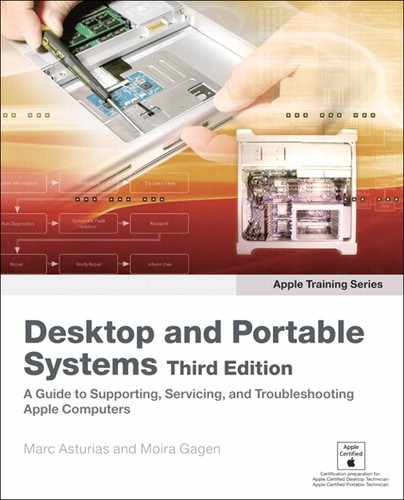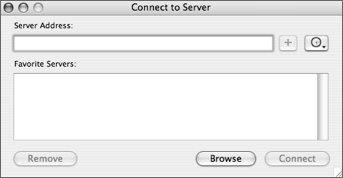Lesson 8. Network Troubleshooting
Reference Files
Apple General Troubleshooting Flowchart (AGTFwithNotes.pdf)
Questions Worksheet (Questions_Worksheet.pdf)
Cable Modem Reset (Cable_Modem_Reset.pdf)
Useful Links (TS_Links.html)
Time
This lesson takes approximately 2.5 hours to complete.
Goals
Given a troubleshooting scenario, identify the different components of a computer network in terms of nodes, links, and protocols
Given a description of a network problem and Apple references, isolate the problem to a hardware or software issue
Identify three useful tips to remember when using a base station–shared USB printer
Identify steps that demonstrate how to set up a basic wired network, including DSL, cable modem, IP, and Bonjour
Identify how to locate and fix trouble that prevents files from being shared between computers
Define common networking terms and how they relate to troubleshooting
Identify and explain networking error messages or faults
In this lesson, you will apply the general troubleshooting skills that you learned in Lesson 3, “General Troubleshooting Theory,” specifically to network problems. This lesson begins by explaining how to identify the different parts of a network. Then it details the recommended troubleshooting steps and how to apply them to various problem scenarios.
Network Components
Generally speaking, the term network refers to a collection of related things that are interconnected.
A computer network is a communications system that interconnects computer systems and devices. Any computer, printer, or other electronic device connected to a network is called a node. The connection between these devices, called a link, is any data transmission medium (like wires, infrared waves, or radio waves) shared by a set of nodes and used for communication among the nodes. Protocols are rules (or languages) that govern how devices on a network communicate with each other.
A simple network could consist of two computers (nodes) interconnected by an Ethernet cable link and using Transmission Control Protocol/Internet Protocol (TCP/IP) as a protocol.

Networks can be quite simple or very complex. Here’s a look at some examples of possible network components you may encounter:
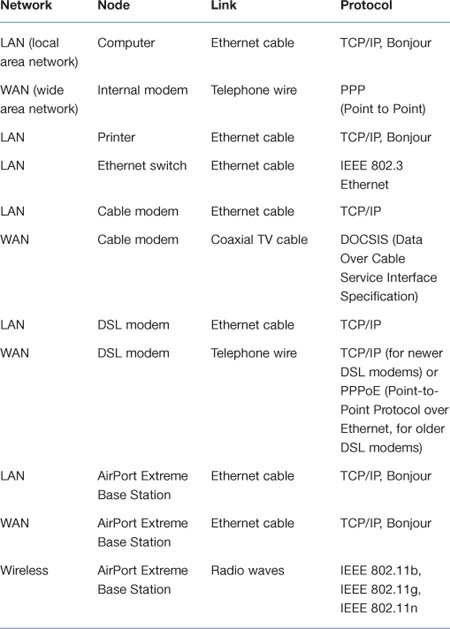
Some products combine a number of these nodes, links, and protocols into a single physical device. When troubleshooting, you may be tempted to think of a base station, a computer, or even a hub as only one node. Network troubleshooting is much easier if you think in terms of nodes instead of devices. An AirPort Extreme Base Station can act as an Ethernet switch, as a router, and as a Dynamic Host Configuration Protocol (DHCP) server, as well as providing wireless connectivity. Likewise, a PowerBook G4 can have multiple nodes, including a modem, Ethernet port, and AirPort port.
When you look at the Info tab of Network Utilities, notice the pop-up menu:

Each one of these interface names can be considered a separate node.
The interconnectivity of network components can make troubleshooting a bit more complex, and you must consider many variables: user and network errors as well as software and hardware problems. Making things more complicated is the fact that some types of errors may be related to network nodes and links you may not have control over, or even access to (such as Internet service provider, or ISP, equipment), so you may not always be able to locate and resolve all network issues without some help. Identifying all of the variables involved and isolating the issue are keys to resolving network issues.
Identifying Network Components
Now that you have a language with which to organize your understanding of a given network, try practicing with some customer scenarios.
A customer describes the following:
“I have an iBook G4 (Early 2004) with AirPort but when I’m in my classroom lab, I can’t print to the lab inkjet printer, only to the laser printer.”
In identifying all of the variables involved and isolating the issue, you might fill in the network components table like this:
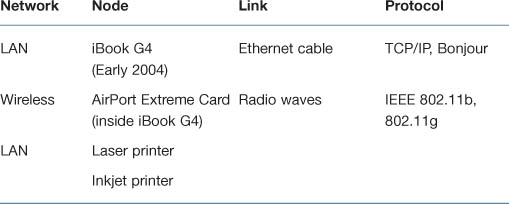
At this point, you can speculate that the inkjet printer must be physically connected to something, possibly another computer or a wireless base station. Likewise, the laser printer must be physically connected to something, probably an Ethernet switch or hub. This would be a good time to ask the customer a few more questions regarding the issue to identify all the variables involved.
A more complete network components table might look like this:

When you’re troubleshooting, you would query the customer to confirm the information in each of these boxes. Remember that the user is also a variable in isolating the issue, and examining the actual network setup yourself will help ensure you have the full picture.
Component Identification Exercise
For each of the following customer scenarios, fill out a network components table on a separate sheet of paper. Consider the possible components.
• Scenario A: “I keep getting a ‘server not found’ error when I try to view webpages. I’m running Safari on my Power Mac G5. The computer is hooked up to a DSL modem.”
• Scenario B: “I bought an AirPort Express Base Station so I could hook it up to my cable modem and surf the Internet from wherever, but it’s not working. I can’t get onto the Internet.”
• Scenario C: “I took my new PowerBook with me on a business trip last week. I usually use high-speed Internet, but this hotel had only dial-up connections in the room. I couldn’t make it work.”
Troubleshooting Tools
Your first lines of defense in network troubleshooting are common applications, the Mac operating system, and bundled utilities.
Applications are the easiest methods of testing a connection. The utilities and diagnostics are more important in advanced troubleshooting of unresolved issues. Remember, one of the first things you must determine is whether your issue involves a single computer, multiple computers on your local network (your LAN), your ISP’s equipment (WAN), or the Internet site you are trying to access. Because the Internet as a whole does not fail entirely, even large Internet-related problems are usually isolated to a single ISP, a small part of the overall Internet, or just a single website or server.
Applications
Use the following applications to help verify network problems and narrow your focus. These are part of the “try quick fixes” step of the troubleshooting chart.
Safari
You can use a browser, such as Safari, to determine if an Internet problem is isolated to a specific site or to your connection through the Internet to that site. If the browser displays an error when accessing one site, but not another, the problem is likely with just that site.
Using an alternative browser such as Firefox, OmniWeb, or Opera may reveal whether the problem is related to a specific browser’s interaction with the site or a software preferences setting in a particular browser.
Browsers also create network activity when they attempt to access a remote webpage. This activity tasks the computer with acquiring an IP address via DHCP (if one has not already been assigned) to support that network activity, which you can use to both verify connectivity and to identify the particular network to which a computer is connected.
Attempting to send or receive mail can help you determine if you have an Internet connection.
If you can’t get or send mail but can view uncached webpages, you have access to the Internet but have either a mail server issue or an ISP port blocking issue.
Or, if you can receive and send mail but can’t load webpages, you have access to the Internet but have a Web-related (that is, HTTP) issue. If you use Mac OS X 10.4 Mail, you can try an additional tool called the Mail Connection Doctor (described in the “Utilities” section, later in this lesson). It checks all relevant functions of your incoming and outgoing mail servers for connectivity and validity, alerts you to any problems, and suggests troubleshooting techniques.
More Info
Port blocking by ISPs has become a common tool in fighting spam. Spamming is the unscrupulous business practice of sending unsolicited bulk electronic messages in junk email and other forms as an inexpensive way to reach consumers. Many ISPs block port 25 on their networks because it is a commonly abused port by spammers, leaving users to reconfigure their email client to use an alternate port or electing to use the ISP’s mail services. To explore the topic of port blocking further, using a .Mac user as an example, consult Apple Knowledge Base document 151534, “I can’t send mail because the connection to the server on port 25 timed out.”
iChat
iChat instant messages can be transmitted over the Internet (WAN) via its connection with a valid messaging service such as AIM, ICQ, .Mac, Jabber, or an iChat service from a server using Mac OS X 10.4. iChat messages can also be sent locally over a wired or wireless LAN via the Bonjour protocol.
If you can send instant messages locally via Bonjour to another iChat client on your LAN but not to anyone else over the Internet via a known-good service you have used before, a WAN issue might be preventing this communication.
The Connection Doctor in iChat displays the audio and video stream throughput for both the local and remote sides of the chat. You can use this tool to help determine if any network bottlenecks may be preventing you from communicating via iChat.
iChat instant messaging and iChat AV use a series of ports that must be open for their use. If the network is using a firewall or if a firewall exists anywhere along the path of the network, the correct ports must be open.
More Info
For additional information on how to best configure a network for use with iChat AV, consult Knowledge Base document 93208, “Using iChatAV with a firewall or NAT router.” For information on using Bonjour on your local network, read “iChat 3.0 Help: Chatting on your local network” (http://docs.info.apple.com/article.html?path=iChat/3.0/en/fz42.html).
Operating System
Use the following operating system functions to help you verify network problems as another “try quick fixes” step of the troubleshooting chart.
Network Preferences
Network preferences should be one of the first places to check when experiencing connectivity issues. Under Network Status, are the status indicators green, indicating a functioning Internet connection? Or are they yellow or red, indicating a more basic problem, such as a self-assigned IP address?
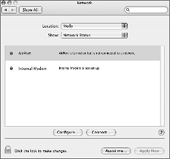
To check the IP address, choose the port you want to check from the Show pop-up menu, then click the TCP/IP button. When in doubt, click the Assist Me button to use the Network Assistant to create a new network location configuration, which will verify that all network preference settings are using default settings, while leaving the existing settings unchanged.
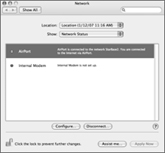
Note
Addresses in the self-assigned range (169.x.x.x) are usually not routed for traffic on the public Internet. A 169 address typically indicates that your DHCP server is not assigning you a valid IP address or that you cannot connect to the network to receive the address. Though it is a very rare practice, be aware that your ISP or institutional network could choose to assign these addresses and route them within their private network.
Connect to Server
In the Finder, press Command-K or choose Connect to Server from the Go menu. After the window opens, click Browse, which may help you determine where a connection failure is occurring. After you click Browse, the system sends a broadcast message to the network, asking any servers to respond with their hostnames, which the Finder then displays in a window.
Do you see any other servers or shared Macintosh or Windows computers on your local network (LAN)? Were you able to browse and find a server, but were unable to connect to it? Were you expecting to see a large number of servers on the network and see none or only a few?
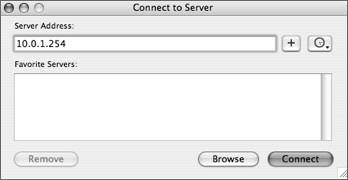
If you have never connected to a server before or if you have deleted your favorite server entries, the Connect to Server window will be empty. Mac OS X provides an auto-fill function that will display a previously typed information the next time you open the Connect to Server window and begin to type an IP address or server name in the Server Address field.
Once you click Connect, a Connecting to Server message appears.
![]()
Can you connect to a specific server to which you’re sure you should have access? Can you connect to other computers using AppleTalk or the server IP address? If the server was not immediately found, an AFP Connection Status message may be displayed as the system attempts to resolve IP addresses to hostnames via DNS.
![]()
Such connection attempts may last as long as several minutes before timing out. If this happens, a dialog box informs users that the server to which they are trying to connect is not reachable at this time.

If you cannot connect to a particular server or have entered an incorrect IP address, the connection will fail. Are you using the correct IP address?
Answering questions such as these can help you isolate the issue before reaching for one of the utilities discussed in the next section.
More Info
For additional information on connecting to another computer or server using an IP address, read “Mac OS X 10.4 Help: Connecting to shared computers and servers using a network address” (http://docs.info.apple.com/article.html?path=Mac/10.4/en/mh1158.html).
Utilities
Use the following utilities to help during the “diagnostics, research, and/or repair” steps of the troubleshooting flowchart.
Apple Service Diagnostic
Service providers use Apple Service Diagnostic (ASD) to perform low-level tests of a number of Apple systems. Much like Apple Hardware Test (AHT), ASD does not rely on the system’s Mac OS in order to check hardware components.
System Profiler
System Profiler is a Mac OS X utility that gathers and displays information about a computer. System Profiler can show you the internal components and external peripherals that the computer recognizes, as well as the operating system version, serial number, what versions of software have been installed, and more. Although System Profiler is not touted as a diagnostic utility, it can be valuable during troubleshooting to verify whether the operating system can recognize installed internal hardware components (such as random-access memory [RAM] or an AirPort Extreme Card) and external connections (such as network connections and even mounted server volumes).
Network Diagnostics
Network Diagnostics is a powerful troubleshooting utility first introduced in Mac OS X 10.4 Tiger. It automates many of the troubleshooting steps outlined later in this lesson, and provides context-sensitive, step-by-step instructions that can assist a user in isolating a specific networking issue. It works with built-in Ethernet, internal modem, or AirPort connections, and several Mac OS X 10.4 applications such as Finder, iChat, Mail, and Safari have been updated to take advantage of Network Diagnostics when a network connectivity issue arises. For more information, search Mac Help for “network diagnostics.”
Network Utility
Network Utility is a very powerful collection of tools for gathering information and troubleshooting network connection issues in Mac OS X. One function of the Network Utility enables you to perform a simple network test, known as a ping, to verify network connectivity to a designated URL or IP address. Another function, called traceroute, literally traces the route of a packet through a TCP/IP network to a destination.
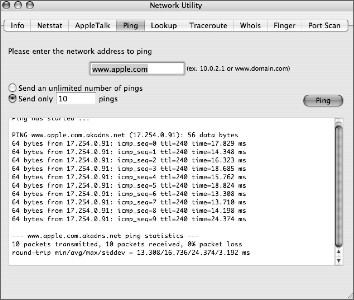
AirPort Admin Utility
The AirPort Setup Assistant and AirPort Express Assistant are great for setting up a base station, but AirPort Admin Utility allows you to make very specific changes that the assistant won’t. AirPort Admin Utility enables you to open or restrict access to a base station and Internet connection, change the base station’s frequency, or change the type of wireless security used on the network. You can administer AirPort, AirPort Extreme, and AirPort Express Base Stations from one interface.
Apple Hardware Test
AHT can detect problems with the computer’s internal hardware components such as the logic board, memory, modem, video RAM (VRAM), and AirPort Card. It does not check externally connected hardware components, nor does it check non-Apple devices such as PCI cards from other vendors. AHT can help eliminate a computer as a suspect during network troubleshooting.
AirPort Management Utility
Found on the software CD included with the AirPort Extreme Base Station (PoE/UL 2043), the AirPort Management Utility (AMU) enables you to configure, manage, and monitor all AirPort Base Stations on a network, all at once from a single location. You can view rolling event base station logs, group a number of base stations, individually confine their wireless range, and visually compare their configuration settings. This utility can also monitor and graph the wireless signal strength to each AirPort client node over a 5-minute period, which can be very useful in troubleshooting connectivity, base station placement, and interference issues.
Mail Connection Doctor
The Mail Connection Doctor checks the connection to the Internet and to each incoming and outgoing mail server. If it has trouble connecting to a particular server, a red dot will appear in the Status column. Next to each account name you see some additional information in the Details column.
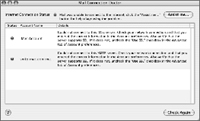
Console
Console is a Mac OS X utility that displays log files created by the computer to record error messages generated by applications and background processes. The main benefit of reading log files is that they can provide more information about an issue than an error message in a dialog. Log files may also contain messages that are never displayed to the user.
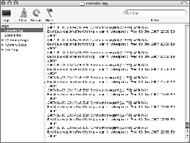
Each entry in a log file is time- and date-stamped, which can help you research past events or to help troubleshoot an issue that you can readily reproduce (like failing to connect to the Internet, for example).
Terminal
The foundation of Mac OS X is an implementation of the BSD version of the UNIX operating system called Darwin. Terminal is an advanced troubleshooting tool that allows you to issue UNIX commands in a command-line interface to accomplish tasks. Most customers will not be comfortable using UNIX commands and typically will never need to use Terminal. Some service and support technicians may prefer to use Terminal when troubleshooting various problems, such as network issues. The troubleshooting recommendations and steps in this book will not focus on UNIX Terminal commands, and instead will use graphical user interface (GUI) utilities wherever possible.
More Info
If you are interested in learning more about BSD and Mac OS X, and consult Knowledge Base document 43139, “Mac OS X: What is BSD?”
Troubleshooting Steps
In Lesson 3 you learned about the Apple General Troubleshooting Flowchart, which documents the Apple recommended troubleshooting steps. A condensed version of this chart might look something like this:
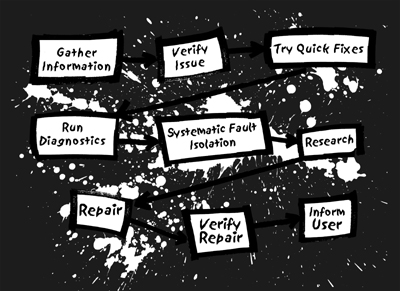
You might want to print the full flowchart (available on the book’s companion website) to have it handy as you work through the following customer scenario (what you saw as Scenario A in the “Component Identification Exercise” section, earlier in this lesson):
“I keep getting a ‘server not found’ error when I try to view webpages. I’m running Safari on my Power Mac G5. The computer is hooked up to a DSL modem.”
According to the flowchart, your next step is to gather information.
Gather Information
Gather information by asking good questions related specifically to the network issue at hand. Remember that the questions you ask during this step fall into two categories: open-ended questions and closed-ended questions. Here are some network-related examples of each:
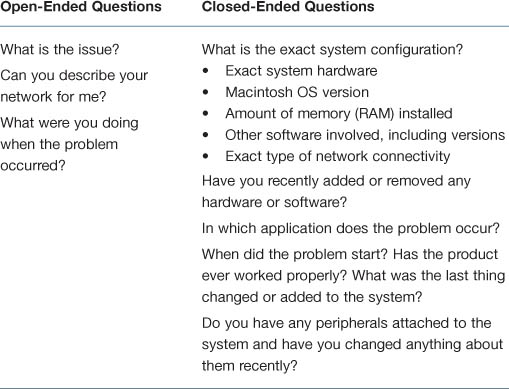
Tip
As you finish asking the customer questions, you might ask a simple but important one: “What else?” This very open-ended question can bring to light many details the customer may have overlooked, and it can provide a path for more specific questions as a follow-up. Once you have received a response, you may even ask it a second time. The customer will realize that you not only care about their situation, but that you are thorough and completely understand the problem at hand.
Your goal in asking these questions, in addition to gaining customer agreement that you understand the problem, is to be able to duplicate the issue. For network issues, you must understand the customer’s network in terms of nodes, links, and protocols.
Nodes, Links, and Protocols
You already took a stab at describing this network in terms of nodes, links, and protocols a few pages back in the component identification exercise. Your table should look something like the following:

Notice that this scenario includes two more nodes: the telephone company’s equipment and the ISP’s router that connects to the Internet. These additional nodes and links are typically very much a part of any scenario involving a customer’s subscribed connection to the Internet, even though customers typically have no control or access to this equipment whatsoever. If this external equipment were to fail, the customer might not have any Internet access, and no amount of local troubleshooting will resolve these kinds of problems; generally, they are solely the ISP’s responsibility. It’s important to recognize that these kinds of problems can occur, and although it might be possible to isolate the issue to the ISP’s equipment, it might also be impossible to resolve such issues without contacting and working with the ISP.
Taking this scenario a step further, to solve network problems, drawing a topological map is often very useful.
Topo Map
A topological map, or topo map, visually depicts the arrangement in which the nodes of a network are connected to each other with links. A map of this test scenario might look like the following:
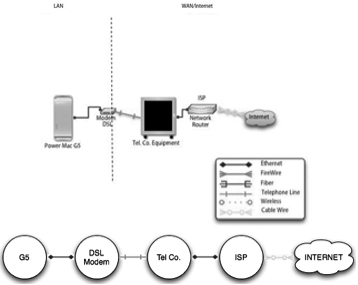
With the customer’s answers to your questions, the network component table, and a map of the network’s topology, you should now have the information you need to verify the problem.
Verify the Problem
Using the information you have gathered, set up the system and try to re-create the problem. If you’re working with a customer over the phone, guide the customer through re-creating the problem as you would.
In network troubleshooting, you want to try to reach the network destination a few different ways. For example, if the customer is having trouble printing to a network printer, try accessing other nodes using the same protocol, like a LAN or WAN webpage (both nodes using TCP/IP). In this way, you are already starting to isolate the exact nature of the problem.
During this troubleshooting step, make detailed notes of any error messages that appear and note how long it takes for the message to appear. For example, getting a “server not found” error message could take up to a minute for a web server that’s busy or on the far side of a malfunctioning router on a WAN. You will get the “server not found” message almost instantly if the problem is closer to the computer on the topo map (for example, if the Ethernet cable is not attached to the computer).
In this scenario, you first ask to specify a webpage the customer can’t get to, and you both try accessing www.google.com. This is a good page to try to load because it’s public, it’s on the WAN/Internet, and normally it’s quick to load.
After about 10 seconds, the customer describes the following error message:
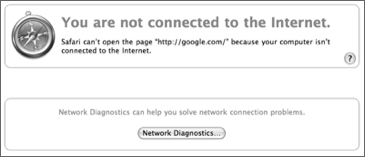
On the topo map you drew of this network, how far do you think the network request is getting?
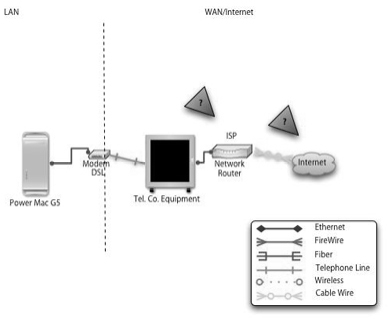
Use Network Diagnostics
Select the Network Diagnostics button.
Network Diagnostics is a new, powerful troubleshooting utility in Mac OS X 10.4 Tiger. It automates many of the manual troubleshooting steps outlined earlier in this lesson. If you are using Mac OS X 10.4 and a networking issue arises, the system may automatically guide you to use Network Diagnostics, which will check various settings and let you know what to check or do next, step by step.
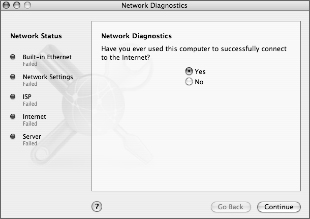
Once you have followed the steps that Network Diagnostics has provided, you should have sufficient information to verify the problem. It’s time to try quick fixes.
Try Quick Fixes
Remember that a quick fix is a repair action that:
• Can be performed quickly
• Involves little or no risk of harm to the system
• Has little or no cost
Here are some network-specific quick fixes:
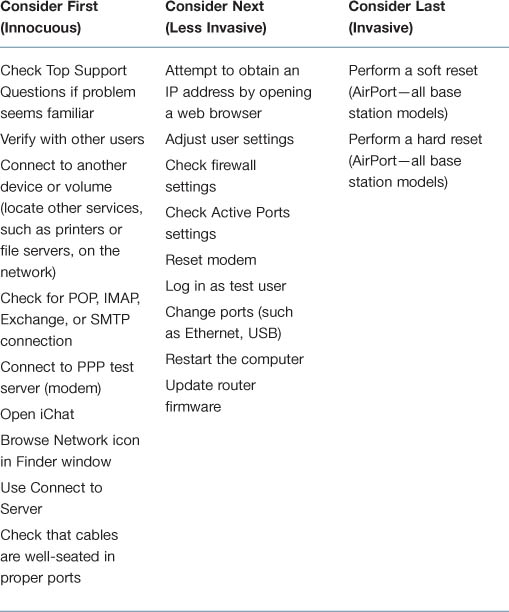
More Info
Refer to “Creating and Connecting to Networks” at www.apple.com/support/panther/network (for Mac OS X 10.3) or www.apple.com/support/tiger/network (for Mac OS X 10.4). These pages list handy troubleshooting articles, organized by symptom or customer question.
When you’re considering quick fixes, in addition to starting with the least invasive relevant options and working toward the more invasive options, it helps to think in terms of user-, software-, OS-, hardware-, and network-related fixes. Consider these possible causes of network-specific problems:
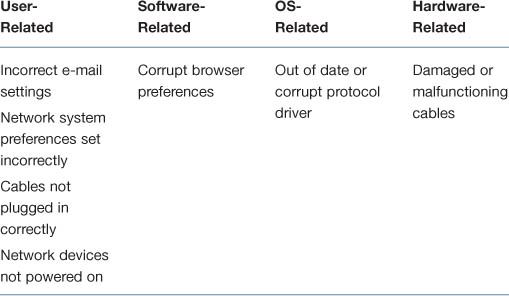
Note
The RJ-11 connector on a telephone wire is very similar to the RJ-45 connector on an Ethernet cable. In fact, it is possible to plug the RJ-11 connector into most Ethernet ports, although Apple has made physical changes to these ports in recent computers to prevent this possibility. Keep this in mind when facing dial-up modem connection problems.
In this scenario, you’ll need to check the settings for built-in Ethernet in Network preferences or direct the customer to do so.
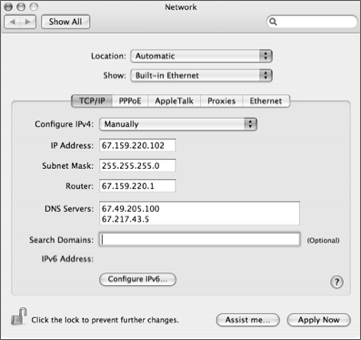
Comparing what the customer tells you with what the customer’s ISP recommends, you find that the customer has configured this port incorrectly for a manual IP address; the ISP requires that the built-in Ethernet be configured to accept IP addresses from a DHCP server.
Have the customer reconfigure Network preferences, then click Apply Now.
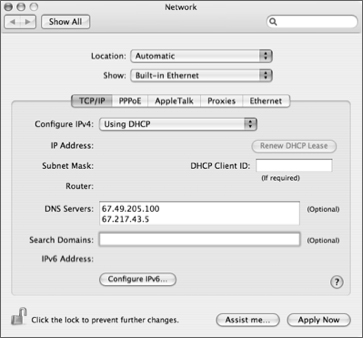
It may take a few moments for the change to take effect. From the Show pop-up menu, choose Network Status. The status indicator should be green for built-in Ethernet, indicating it has a valid IP address and is properly connected to the Internet.
You may consider trying these other quick fixes in the following order:
- Have the customer inspect cables and verify that they are plugged in completely at both ends.
It’s possible, for example, for an Ethernet cable to be in the port partially without being clicked in. In this case, the connection won’t be formed.
- Have the customer verify that the DSL modem has power.
- Have the customer use Network Utility to verify that there is a valid, active link for the built-in Ethernet port (en0).
The Info pane in Network Utility should look something like this:
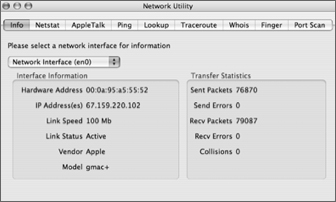
The Link Status is a software equivalent of a physical “link light” on a hub or switch. It simply reflects whether the Ethernet network interface card (NIC) circuitry is recognizing that the Ethernet cable is connected properly to live equipment at both ends.
- Check network preferences settings against the recommendation of the customer’s ISP.
If you map these four quick fixes to user settings–, software-, OS-, or hardware-related fixes, you get the following:
- User settings-related: Check Network preferences...
- Hardware-related: Have the customer inspect cables (this could a user-related issue as well, as cables can be damaged by user neglect)...
- Hardware-related: Have the customer verify that the DSL modem...
- Hardware-related: Have the customer use Network Utility...
Statistics show that over half of the problems seen in service are related to user settings or software/OS. Do you see how eliminating user settings first, then software-, then OS-, and then hardware-related potential problems, usually solves the problem faster?
As the name implies, a quick fix can—and often does—fix the problem. If that is the case, the next step on the flowchart is “repair/replace.” Otherwise, you must use diagnostics and the subsequent flowchart steps to learn about network troubleshooting specifics.
Run Diagnostics
Diagnostic tools are software packages that enable you to check the performance of a system. You learned about these tools in Lesson 2, “Software Tools.”
Some network troubleshooting diagnostic tools are:
• System Profiler
• Network Utility
• AHT
• ASD (for modem and AirPort Extreme Card)
Note
ASD is available to Apple Authorized Service Providers (AASPs) and Apple Technician Training (ATT) customers only.
Conduct Systematic Fault Isolation
The systematic fault isolation procedure (also known as split-half search), covered in Lesson 3, successively eliminates half the system as a possible trouble source. This is the one of the most efficient systematic search techniques. After you are left with a minimum of components, your chances of isolating the problem become more probable. Network troubleshooting examples using this technique include the following:
• Disconnect or eliminate third-party products (for example, USB or FireWire peripherals, PCI cards, and other third-party hardware): Is it an issue with an Apple product or non-Apple product?
• Compare WAN, LAN, and wireless connectivity: Is it an issue with local connectivity or in the network?
• Test within and outside subnet: Is it an IP issue?
• Disconnect all external devices: Is it an issue within the computer or with a peripheral?
Research the Problem
If you have completed the steps described so far on the flowchart and still can’t determine the source of the problem, check these additional resources for network troubleshooting:
• Internet Connect’s connection log
• AirPort Management Utility
• Console logs (specifically DirectoryService.error.log and DirectoryService.server.log, located in Library/Logs/DirectoryService)
• Verbose logging
• Apple Knowledge Base
• Developer Technical Publications (http://developer.apple.com/documentation/index.html)
• Users Guide
The Directory Service log reports authentication errors, date, and time.
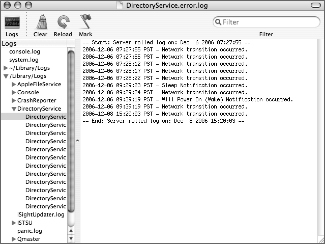
Escalate the Problem
If you still cannot solve a problem despite your best efforts, you may need to escalate the issue to Apple. How you conduct this escalation will depend on where you are located and the practices and policies of your business or agency. Escalation is not a troubleshooting step per se and therefore is not on the flowchart.
Repair or Replace
After determining the source of a problem, you need to repair or replace the faulty item. In Lesson 3 you learned the steps you must take before starting to replace software or hardware. When resolving network-related issues in Mac OS X, creating a new location in Network preferences or with the Network Assistant is a good idea. In this way, you will be able to adjust various settings during the repair without altering the customer’s existing network settings.
Some troubleshooting steps involved during network-related repairs include the following:

Remember that you may have already implemented a repair as part of your “try quick fixes” step in the flowchart.
In your scenario, once you had the customer describe the Network preferences settings and change them to what the ISP requires, you implemented the repair. Your next step is to verify the repair.
Verify the Repair
To ensure a positive customer experience, thoroughly test every product you repair before telling the customer it is fixed.
Network troubleshooting-specific verifications include the following:
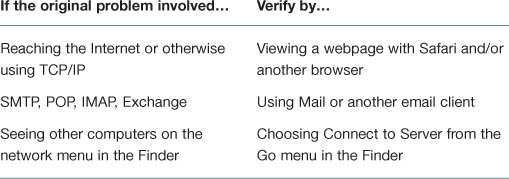
Tip
Throughout this book you will see references to several browsers that can be used for troubleshooting natively in Mac OS X. Safari is the browser of choice, but you need to have a reliable second browser tool as well. Many browsers are on the market, among them Firefox, OmniWeb, Opera, and Internet Explorer. Microsoft no longer supports Internet Explorer 5 for Mac.
Try to duplicate the original problem the customer described. If you can’t, and you’ve satisfied the other recommendations in the “verify repair” section of the Apple General Troubleshooting Flowchart, move on to the next step in the flowchart and inform the user of what you’ve done to repair the system.
Recall that in the “verify the problem” step, the customer couldn’t view the Google webpage. You have the customer try this again, and the page loads almost instantly. You can now move on to the Inform User step on the flowchart.
Inform User
Once you have returned the computer to normal operation (or escalated the problem), inform the customer of what you did to repair the system. Some specific communication tools you have for network-related troubleshooting include the following:
• Screen shots from Network Utility
• Screen shots from Network preferences
• References to appropriate Knowledge Base documents
Now that you’ve helped the customer configure the IP settings correctly, you might suggest that the customer print or save a screen shot of the settings. By educating the customer in a very courteous way, you will be providing them good customer service and may gain a loyal customer long-term.
Complete Administrative Tasks
You may have to complete administrative tasks after troubleshooting an Apple product. This will depend on where you are located and the internal policies of your business or agency. There are no administrative tasks specific to network troubleshooting.
After closing the conversation with the customer, complete whatever administrative tasks your organization requires.
It shouldn’t take you more than 10 minutes to troubleshoot a problem like the one in this scenario, from gathering information to completing administrative tasks.
Practice
Now that you’ve stepped through Scenario A, you can practice the whole process yourself. Read the scenarios, follow the troubleshooting steps, and document what you did:
• “I bought an AirPort Express Base Station so I could hook it up to my cable modem and surf the Internet from wherever, but it’s not working. I can’t get onto the Internet.”
In your conversation with the customer, you discover that the network consists of an AirPort Express Base Station and a cable modem linked to the Internet. The customer’s operating system is Mac OS X 10.3.5. This is a recent issue as the system had been working flawlessly. The customer has tried both Safari and another browser, with the same result: can’t load any outside pages.
• “I have two computers at home but I can get onto the Internet only from one.”
The customer describes his network as two computers, an Ethernet hub, and a cable modem. The customer had been able to use the Internet before. This morning his daughter was up before he was, and was already on the computer surfing the Internet. He could not access the Internet on his system. The IP address on the Power Mac G5 is 169.254.204.166, and the iMac address is 67.159.220.37. Both computers are configured for DHCP. The customer pays for two addresses at his location from the ISP.
• “I can’t get onto the Internet using my wireless connection. I have to hook my PowerBook up to the Ethernet switch to get to the WAN/Internet.”
Discussing the issue with the customer, you are informed that their network consists of a PowerBook G4 (15-inch) using Mac OS X 10.4, a laser printer, Ethernet switch, AirPort Extreme Base Station, and DSL modem. The customer has never been able to get the wireless connection to work. When plugged into the Ethernet switch, you are able to retrieve a webpage instantly, as well as to verify that the customer is using a manual IP address provided by the ISP.
Lesson Review
1. The three components of a network are:
a. Nodes, links, and protocols
b. LANs, WANs, and the Internet
c. Hardware, software, and the OS
d. Computers, cables, and TCP/IP
2. Which of the following is a node?
a. Telephone wire
b. TCP/IP
c. The Internet
d. A printer
Questions 3 through 9 refer to the following scenario and network component table. Fill in the numbered blank cells.
“I bought an AirPort Express Base Station so I could hook it up to my cable modem and surf the Internet from wherever.”

3. What is the node for the wireless network?
a. AirPort Express Base Station
b. Cable modem
c. Computer
d. Printer
4. What is the link for the wireless network?
a. Radio waves
b. Ethernet cable
c. a and b
d. None of the above
5. What WAN link does the cable modem use?
a. Coaxial TV cable
b. Ethernet cable
c. a and b
d. None of the above
6. What protocol does the cable modem use?
a. 802.11g
b. TCP/IP
c. DOCSIS
d. PPP
7. What is the node for the LAN?
a. AirPort Express Base Station
b. Cable modem
c. Computer
d. Printer
8. What link does the LAN node use?
a. Ethernet cable
b. Telephone wire
c. a and b
d. None of the above
9. What protocol does the LAN node use?
a. 802.11g
b. TCP/IP
c. T1
d. PPP
10. Given the following scenario, what network component is missing from the topo map?
“I took my new PowerBook on a business trip last week. I usually use high-speed Internet, but the hotel had only dial-up connections in the room. I couldn’t make it work.”
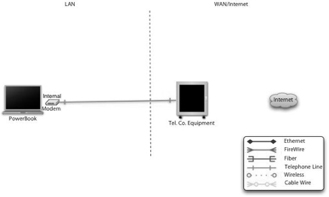
a. Ethernet port
b. ISP’s network router
c. Wireless port
d. DSL modem
11. Which of the following is not usually a relevant question when gathering information for a network problem?
a. What is the exact system configuration?
b. Have you recently added or removed any hardware or software?
c. How much free space is available on the hard disk?
d. Do you have any peripherals attached to the system? Have you changed anything about them recently?
12. Which of the following is a network-specific quick fix?
a. Check the active port configurations in Network preferences.
b. Check Startup Disk preferences.
c. Force quit.
d. Reset permissions.
13. Given a network problem scenario, which of the following would you eliminate last?
a. Network preferences set incorrectly
b. Cables not plugged in correctly
c. Network devices not powered on
d. Damaged or malfunctioning cables
14. Which of the following is not useful for diagnosing network problems?
a. Disk Utility
b. System Profiler
c. Network Utility
d. Apple Hardware Test
15. Which of the following is a troubleshooting step that might be taken during a network-related repair?
a. Run AirPort Admin Utility.
b. Run Network Utility.
c. Check cable connections.
d. Reset PRAM.
e. All of the above
f. None of the above
